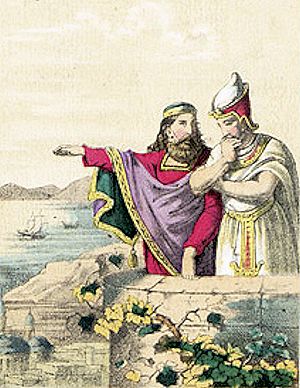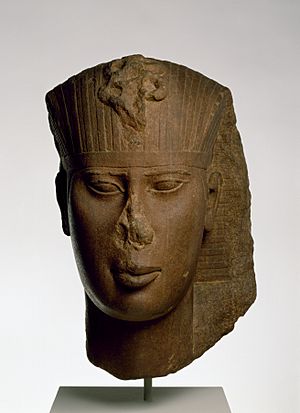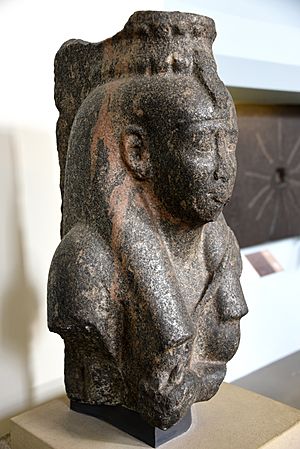Amasis II facts for kids
Quick facts for kids Amasis II |
|
|---|---|
| Ahmose II | |

Head of Amasis II, c. 550 BCE
|
|
| Pharaoh | |
| Reign | 570–526 BCE (26th dynasty) |
| Predecessor | Apries |
| Successor | Psamtik III |
| Consort | Tentkheta, mother of Psamtik III Nakhtubasterau Ladice Chedebnitjerbone II (daughter of Apries) Tadiasir? |
| Children | Psamtik III Pasenenkhonsu Ahmose (D) Tashereniset II ? Nitocris II |
| Mother | Tashereniset I |
| Died | 526 B.C.E. |
Amasis II (Ancient Greek: Ἄμασις), also known as Ahmose II, was an important pharaoh of Ancient Egypt. He ruled for a long time, from 570 to 526 BCE. He belonged to the Twenty-sixth Dynasty of Egypt and took over from King Apries in a city called Sais. Amasis II was the last truly powerful ruler of Egypt before the Persians took control.
Contents
Life of Amasis II
Most of what we know about Amasis II comes from an ancient Greek historian named Herodotus. Herodotus wrote that Amasis came from an ordinary family. He started his career as an officer in the Egyptian army. His hometown was Siuph, near Sais.
How Amasis Became Pharaoh
Amasis became pharaoh because of a revolt. Egyptian soldiers were returning home after an unsuccessful military trip to Cyrene. They suspected that their king, Apries, had tricked them. They thought Apries wanted to rely more on his Greek mercenaries instead of Egyptian soldiers. Many Egyptians agreed with the angry soldiers.
General Amasis was sent to calm the revolt. But instead, the soldiers chose him as their new king! Apries then had to depend only on his Greek soldiers. Amasis defeated Apries. Apries tried to get his throne back with help from the Babylonians, but he was captured and killed in 567 BCE. An ancient stone carving confirms this fight between Egyptian and foreign soldiers. It also shows that Apries was killed and given a respectful burial. To make his rule stronger, Amasis married Chedebnitjerbone II, who was one of Apries's daughters.
Amasis's Family and Court
We know a little about Amasis's family. His mother was named Tashereniset. There is a statue of her in the British Museum today. We also know that his maternal grandmother was named Tjenmutetj.
Amasis had many important officials in his court. Ahmose-sa-Neith was the head of the gate guard and was very famous. Wahibre was in charge of border security, looking after "southern foreigners" and the "doors of foreigners." A doctor named Udjahorresnet also started his career under Amasis. He later became important to the Persians. Several "heads of the fleet" (navy leaders) are also known.
Amasis and the Persians

Herodotus tells a story about how Amasis II eventually caused trouble with the Persian armies. The Persian king, Cambyses II or Cyrus the Great, asked Amasis for an Egyptian eye doctor. Amasis sent an Egyptian doctor to Persia, forcing him to leave his family behind.
To get revenge, the doctor became close to Cambyses. He suggested that Cambyses ask Amasis for a daughter to marry. This would make their friendship stronger. Cambyses agreed and asked for Amasis's daughter.
Amasis worried that his daughter would not be treated well by the Persian king. He also didn't want to anger the powerful Persian empire. So, he came up with a clever plan. He sent Nitetis, the daughter of the former pharaoh Apries (whom Amasis had defeated), to Persia instead of his own daughter.
Nitetis was described as "tall and beautiful." But when she met the Persian king, she told him the truth about Amasis's trick. This made Cambyses very angry, and he promised to get revenge. Amasis died before Cambyses could reach Egypt. His son, Psamtik III, became pharaoh but was defeated by the Persians.
Before this, Cyrus the Great had made agreements with other kings, like Croesus of Lydia and Nabonidus of Babylon. The real goal was to stop Egypt from helping its allies. Once these allies lost Egypt's support, the Persians conquered Lydia in 541 BCE and Babylon in 539 BCE.
Herodotus also wrote that Amasis, like the pharaoh before him, relied on Greek mercenaries and advisors. One such advisor was Phanes of Halicarnassus. Phanes later left Amasis for reasons Herodotus didn't fully know. Amasis sent someone to capture Phanes, but Phanes escaped to Persia. He then met Cambyses and helped him plan the invasion of Egypt. Egypt finally fell to the Persians during the Battle of Pelusium in 525 BCE.
Egypt's Wealth Under Amasis
Amasis II brought Egypt closer to Greece than ever before. Herodotus said that under Amasis's smart leadership, Egypt became very wealthy. Amasis decorated temples, especially in Lower Egypt, with beautiful stone shrines and other monuments. For example, a temple he built was found at Tell Nebesha.
Amasis gave the Greeks a trading city called Naucratis on the Nile river. When the temple of Delphi in Greece burned down, he gave a large amount of money (1,000 talents) to help rebuild it. He also married a Greek princess named Ladice, who was the daughter of King Battus III. Amasis also made alliances with Polycrates of Samos and Croesus of Lydia.
Under Amasis, Egypt's economy, which was based on farming, reached its best point. Herodotus, who visited Egypt less than 100 years after Amasis II died, wrote that:
It is said that it was during the reign of Ahmose II (Amasis) that Egypt attained its highest level of prosperity both in respect of what the river gave the land and in respect of what the land yielded to men and that the number of inhabited cities at that time reached in total 20,000.
Amasis's kingdom probably included only Egypt, up to the First Cataract. But he also added Cyprus to his control, and he had a lot of influence in Cyrene. In his fourth year as pharaoh (c. 567 BCE), Amasis successfully stopped an invasion by the Babylonians led by Nebuchadnezzar II. After this, the Babylonians had too many problems in their own empire to attack Egypt again.
However, Amasis later faced a much stronger enemy: the rising Persian Empire under Cyrus the Great. Cyrus became king in 559 BCE. Amasis's last years were spent worrying about the coming Persian attack on Egypt. Cyrus cleverly defeated Lydia in 546 BCE and then the Babylonians in 538 BCE. This left Amasis with no major allies in the Near East to help against Persia's growing power. Amasis tried to make stronger ties with Greek states to prepare for the Persian invasion. Luckily for him, he died in 526 BCE, just before the Persians attacked. The final battle fell to his son, Psamtik III, who was defeated by the Persians in 525 BCE after ruling for only six months.
Tomb and Desecration
Amasis II died in 526 BCE. He was buried in the royal burial ground at Sais. Even though his tomb has never been found, Herodotus described it:
[It is] a great cloistered building of stone, decorated with pillars carved in the imitation of palm-trees, and other costly ornaments. Within the cloister is a chamber with double doors, and behind the doors stands the sepulchre.
Herodotus also wrote about how Amasis's mummy was disrespected. When the Persian king Cambyses II conquered Egypt, he ended the 26th Dynasty.
[N]o sooner did [... Cambyses] enter the palace of Amasis that he gave orders for his [Amasis's] body to be taken from the tomb where it lay. This done, he proceeded to have it treated with every possible indignity, such as beating it with whips, sticking it with goads, and plucking its hairs. [... A]s the body had been embalmed and would not fall to pieces under the blows, Cambyses had it burned.
Later Reputation

From the 400s BCE onwards, stories about Amasis became popular. These stories came from Egyptian writings, Herodotus, and other Greek writers. In these tales, Amasis was shown as a pharaoh who didn't always act like a typical king. But he was very wise and clever, like a trickster on the throne, or a kind of Egyptian Solomon.
Gallery of images
-
Papyrus, written in demotic script in the 35th year of Amasis II, on display at the Louvre
See also
 In Spanish: Amosis II para niños
In Spanish: Amosis II para niños






